Greece is home to various birds, ranging from small passerines to large waterfowl and from resident species to migratory visitors.
With its warm climate, diverse habitats, and unique topography, Greece is an ideal destination for birdwatchers seeking to observe and experience the beauty of its avian inhabitants.
From the majestic Golden Eagle to the colourful bee-eater, the birds of Greece provide a wonderful opportunity to explore the wonders of nature.
51 Most Beautiful Birds Of Greece
Greece is home to a wide variety of bird species, many of which are fascinating and stunningly beautiful. While it’s challenging to narrow it down to just 51, here is a list of some of the most beautiful birds you can find in Greece:
1. Songbirds
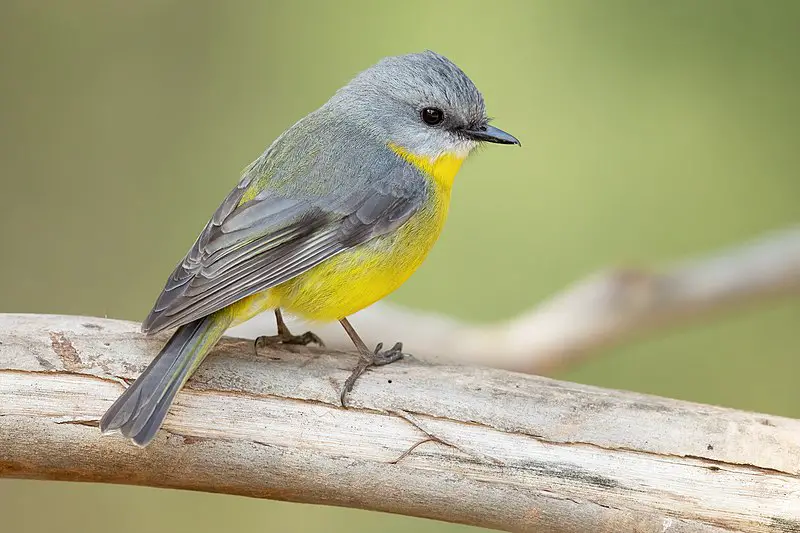
Songbirds are a special suborder of perching birds found all over the world. These beautiful creatures have intricate vocal organs that allow them to produce elaborate bird songs, making them stand out from other species.
With around 5,000 different types of songbirds in existence, they come in various sizes and colours, with complex feathers adding to their beauty.
Songbirds play an important role in ecosystems as they help disperse seeds by eating fruit and insects, which act as agents for pollination.
Their presence also attracts more biodiversity into areas where these delicate animals live, creating vibrant habitats full of life.
Scientific classification:
| Kingdom | Animalia |
| Phylum | Chordata |
| Class | Aves |
| Order | Passeriformes |
| Clade | Eupasseres |
| Suborder | Passeri Linnaeus, 1758 |
2. Crow Family
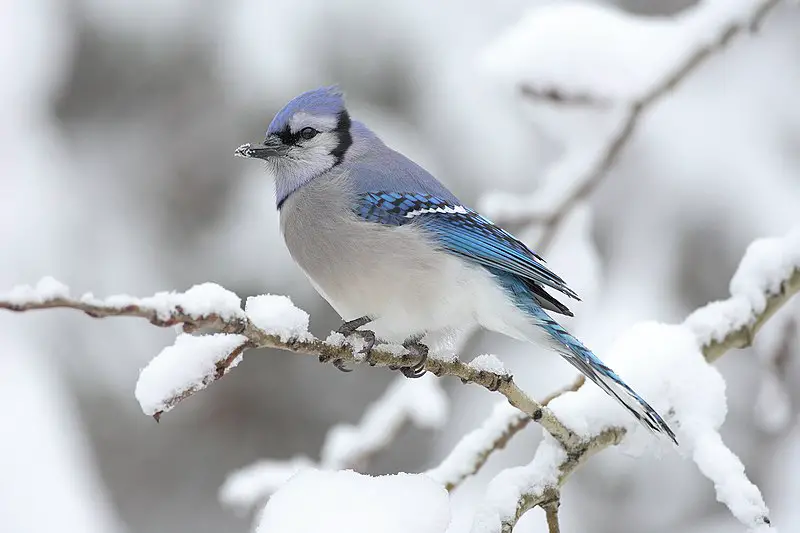
The Crow family is a cosmopolitan group of birds that contains crows, ravens, rooks, jackdaws, jays, magpies and more.
Altogether, there are 133 members in this bird family, which all share similar characteristics such as large beaks and feet.
The genus Corvus alone makes up over a third of the entire crow family population, with species like the common crow or blackbird being some of its most recognizable members.
All these birds have strong social bonds, so they often travel in groups to find food sources or build nests together for protection against predators.
With their intelligence and adaptation skills, they can survive almost anywhere on Earth, from mountains to cities, making them one of the world’s most successful families of avian creatures.
Scientific classification:
| Kingdom | Animalia |
| Phylum | Chordata |
| Class | Aves |
| Order | Passeriformes |
| Superfamily | Corvoidea |
| Family | Corvidae Leach, 1820 |
3. Kingfisher
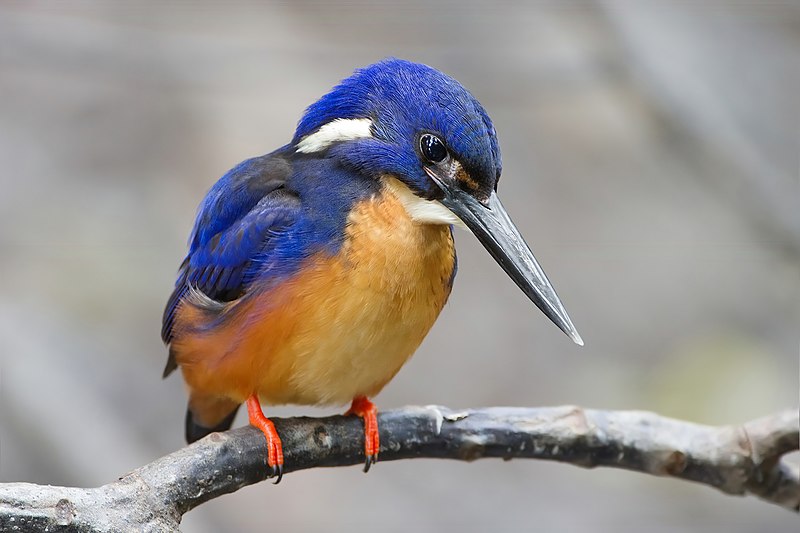
Kingfishers are a vibrant and unique family of birds, with most species found in tropical regions across Africa, Asia, Oceania and Europe.
Their bright colours make them easily identifiable among the foliage of deep forests near calm ponds or rivers.
They come in three subfamilies: tree kingfishers (Halcyoninae), water kingfishers (Cerylinae) and river kingfishers (Alcedinidae).
Kingfisher birds have short legs used for perching along branches overhanging streams or lakes; they also possess strong beaks perfect for catching fish.
These little hunters will remain motionless as if suspended from thin air until an unsuspecting prey comes within reach.
Then, they swoop down quickly to grab their meal. With 116 different species making up this incredible family, there’s something special about every single one.
Scientific classification:
| Kingdom | Animalia |
| Phylum | Chordata |
| Class | Aves |
| Order | Coraciiformes |
| Suborder | Alcedines |
| Family | Alcedinidae Rafinesque, 1815 |
4. Bee-Eater

Bee-eaters are one of the most beautiful and vibrant birds in existence. They have a slender body, long wings, down-turned bills, and their signature elongated central tail feathers, which make them instantly recognizable from afar.
Their plumage is incredibly colourful, with many shades ranging from blues to greens to reds that glisten when they fly through the air.
These stunning creatures can be found all over Africa, Asia, Southern Europe, Australia and New Guinea, where they feed mainly on bees but also other insects like flies or wasps and small mammals such as lizards or rodents.
Bee-eaters live in colonies near rivers or wetlands, so they may easily hunt for food while staying close together for safety.
Additionally it allows them better to display their impressive courtship dances during mating season.
Scientific classification:
| Kingdom | Animalia |
| Phylum | Chordata |
| Class | Aves |
| Order | Coraciiformes |
| Family | Meropidae Rafinesque, 1815 |
5. Hoopoes
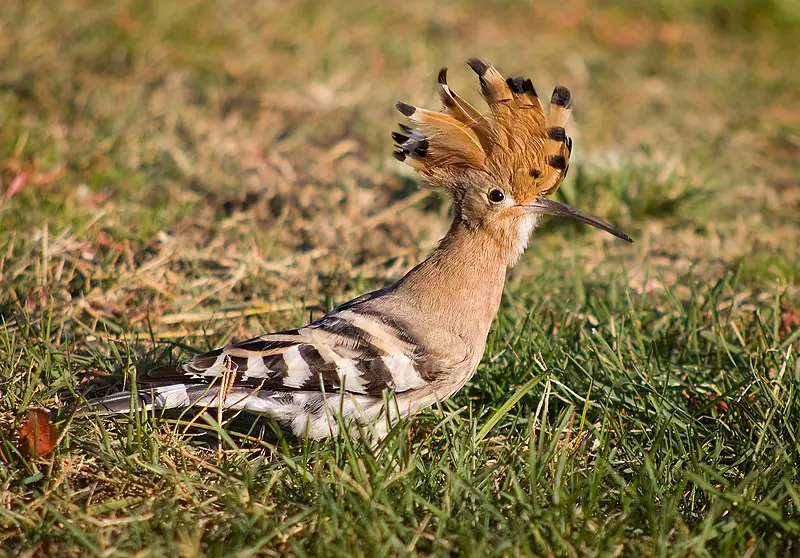
Hoopoes are a fascinating species of bird found across Africa, Asia and Europe. They have beautiful plumage with unique ‘crowns’ of feathers on their heads.
Three living and one extinct species exist – although, for some time, they were all classed as the same species: Upupa epops. Some taxonomists still believe this to be true.
These birds are often associated with royalty due to the impressive crown-like crest atop their head, adding an extra element of mystery and exoticism to these creatures.
Hoopoes can also produce loud calls that sound like “hoo-poo,” which is why they’ve been given such an apt name.
Scientific classification:
| Kingdom | Animalia |
| Phylum | Chordata |
| Class | Aves |
| Order | Bucerotiformes |
| Family | Upupidae Leach, 1820 |
| Genus | Upupa Linnaeus, 1758 |
6. Swifts
Swifts are small, aerial birds that belong to the Apodidae family. They look similar to swallows but aren’t related in any way.
Swifts have evolved differently from other passerines and instead share an order with hummingbirds – the Apodiformes.
The Hemiprocnidae also shares a close relationship with swifts, being referred to as ‘treeswift’ due to their affinity for perching on trees rather than flying through the air like regular swifts do.
While these two species may appear quite similar at first glance, closer inspection will reveal vast differences between them, which have come about over time via convergent evolution.
Scientific classification:
| Kingdom | Animalia |
| Phylum | Chordata |
| Class | Aves |
| Order | Apodiformes |
| Family | Apodidae Hartert, 1897 |
7. Shrike
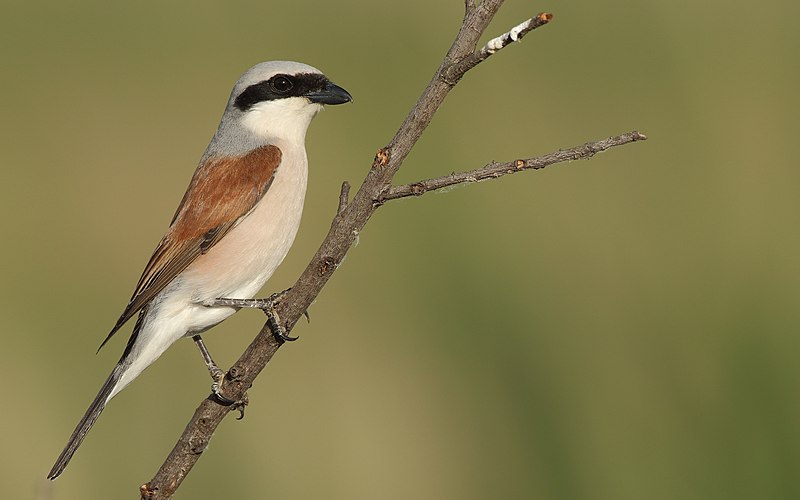
Shrikes are small passerine birds of the family Laniidae, with 34 species in four genera. They get their name from the Old English word “scrīc”, which refers to their shriek-like call.
These birds have earned the nickname ‘butcherbirds’ due to their feeding habits; they impale prey on thorns or barbed wire fences for later consumption.
Shrikes also tend to be aggressive predators and hunt a wide range of animals, such as insects, small reptiles, rodents and even other smaller bird species.
In terms of physical appearance, these songbirds can vary greatly depending on the specific genus but usually boast a large hooked bill atop an impressive crest and bright colours like grey, black or brownish hues across their feathers.
It’s clear that the Shrike is quite a remarkable creature that has gained notoriety for both hunting prowess and distinctive vocalizations.
Scientific classification:
| Kingdom | Animalia |
| Phylum | Chordata |
| Class | Aves |
| Order | Passeriformes |
| Superfamily | Corvoidea |
| Family | Laniidae Rafinesque, 1815 |
8. Bearded Reedling
The Bearded Reedling is a small passerine bird found in reed beds across Europe, Asia and North Africa.
It is easily identified by its distinct black and white plumage, with males having yellow faces.
This species belongs to the only family of birds known as Panuridae and was first described by Carl Linnaeus back in 1758.
They feed on insects such as beetles, flies, and moths, among others, but also consume seeds from plants like sedges or rushes during winter months when food availability decreases significantly.
These birds are territorial, meaning that they have their own area where they live, which can vary from 8 to 12 hectares depending on the seasonality of insect abundance within these areas, making them an important part of maintaining healthy ecosystems in wetlands around their range.
Scientific classification:
| Kingdom | Animalia |
| Phylum | Chordata |
| Class | Aves |
| Order | Passeriformes |
| Family | Panuridae Des Murs, 1860 |
| Genus | Panurus Koch, 1816 |
| Species | P. biarmicus |
9. Grebes
Grebes are a type of diving bird found in freshwater habitats worldwide. They belong to the order Podicipediformes and have 22 species that exist across six genera.
Some species can also be found in marine environments during their migration or winter season, and some even live flightless lives on stable lakes.
Grebes vary greatly between regions; for example, they range from 4-32 inches long with anywhere from 8-30 ounces of weight, depending on the species.
Their plumage may be black, browns/greys or whites but usually consists of bright colours such as yellows, blues and greens. While underwater, they use these feathers to help them streamline through the water quickly.
Scientific classification:
| Kingdom | Animalia |
| Phylum | Chordata |
| Class | Aves |
| Clade | Neoaves |
| Clade | Mirandornithes |
| Order | Podicipediformes Fürbringer, 1888 |
| Family | Podicipedidae Bonaparte, 1831 |
10. White Stork
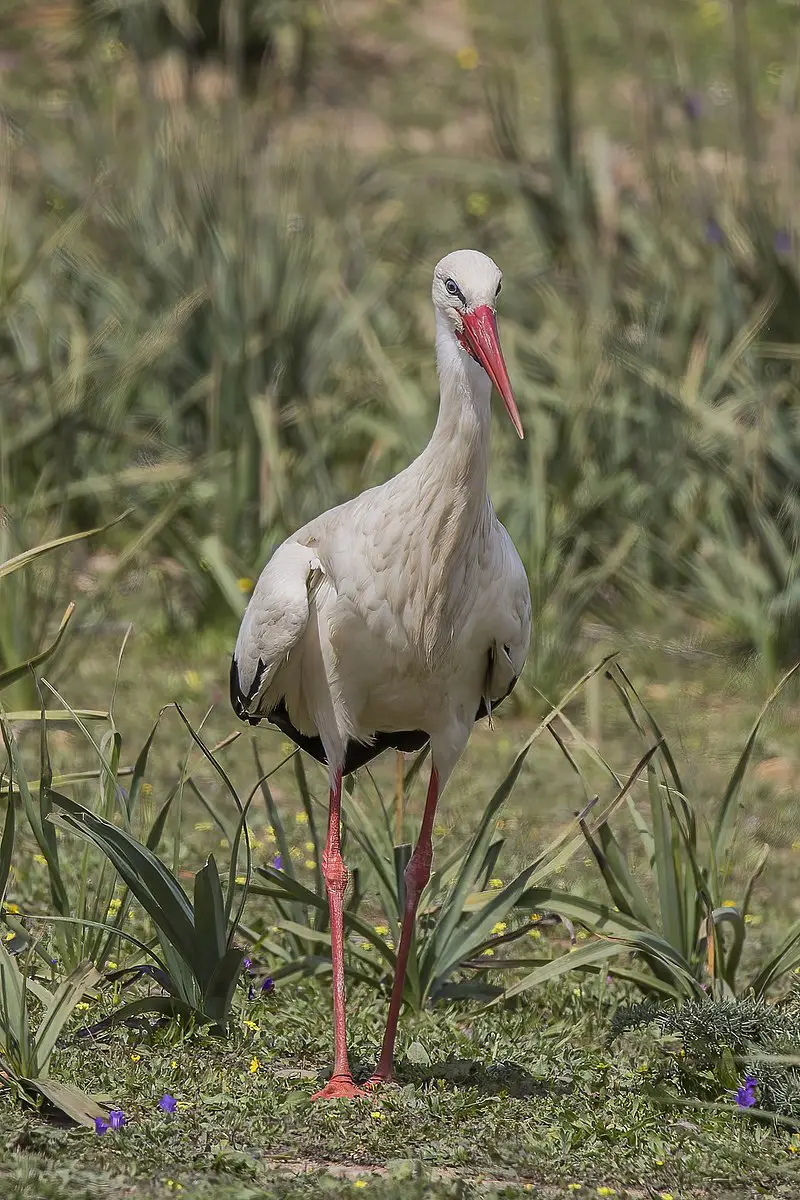
The White Stork is a majestic European bird with white plumage and black wings. It has long, slender legs and beaks that are usually bright red in colour.
The average adult stands around 100 – 115 cm tall from beak to tail tip, while its wing span can reach up to 155-215 cm wide. There are two subspecies of the White Stork, which differ slightly in size.
They feed on small animals such as frogs, fish or insects and nest near human dwellings due to the abundance of food available there; they also build nests atop chimneys or roofs when given the chance.
These birds have been revered for centuries as symbols of fertility because their return each spring often coincides with an increase in births among humans living nearby – something superstitious people take great note of.
Scientific classification:
| Kingdom | Animalia |
| Phylum | Chordata |
| Class | Aves |
| Order | Ciconiiformes |
| Family | Ciconiidae |
| Genus | Ciconia |
| Species | C. ciconia |
11. Eurasian Golden Oriole
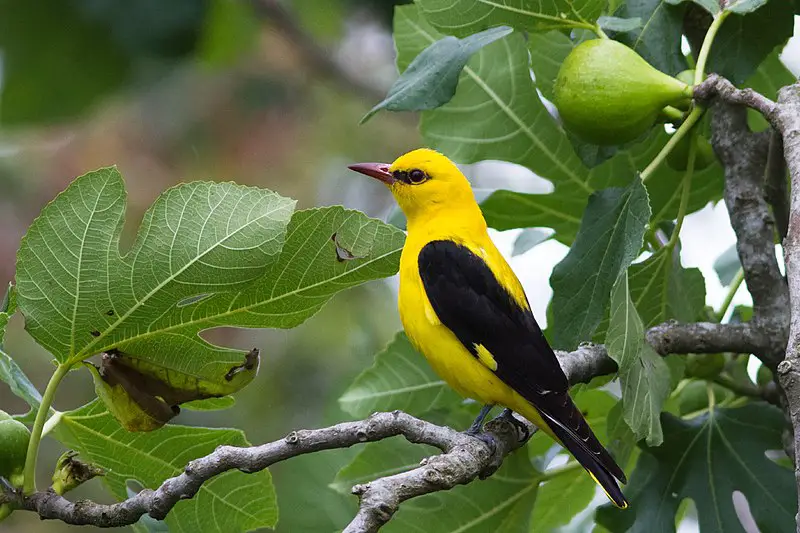
The Eurasian golden oriole is a beautiful bird belonging to the Old World oriole family of passerine birds that breed in temperate climates of the Northern Hemisphere.
It migrates from Europe and the Palearctic during the summer season and spends its winter months in central and southern Africa.
These birds have an impressive range with large populations that appear stable or increasing across much of their range due to conservation efforts.
They are mostly found near forests, woodlands, riverbanks and meadows, where they feed on fruits and insects such as caterpillars, beetles, grasshoppers, etc.
The males can easily be identified by their bright yellow plumage, while females are more olive-coloured.
All in all these stunningly colourful creatures add vibrancy to our environment.
Scientific classification:
| Kingdom | Animalia |
| Phylum | Chordata |
| Class | Aves |
| Order | Passeriformes |
| Family | Oriolidae |
| Genus | Oriolus |
| Species | O. oriolus |
Also Featured In: Birds That Live in the Jungle, Turkey Birds You Should Know
12. Eleonora’s Falcon
Eleonora’s falcon is a medium-sized bird of prey belonging to the similar species’ hobby group. It has distinct features such as its light brown back, white belly and dark eye stripe.
This stunning creature can be found in parts of Europe, North Africa and Asia Minor, where it feeds mainly on lizards, large insects and small birds.
Its conservation status is currently stable due to successful breeding programs across many countries, which have helped prevent further decline in population size.
Eleonora’s Falcon also plays an important role in maintaining balance within ecosystems by controlling pest populations like mice or locusts.
All these attributes make this beautiful raptor a truly remarkable animal worthy of admiration.
Scientific classification:
| Kingdom | Animalia |
| Phylum | Chordata |
| Class | Aves |
| Order | Falconiformes |
| Family | Falconidae |
| Genus | Falco |
| Species | F. eleonorae |
13. Eurasian Collared Dove
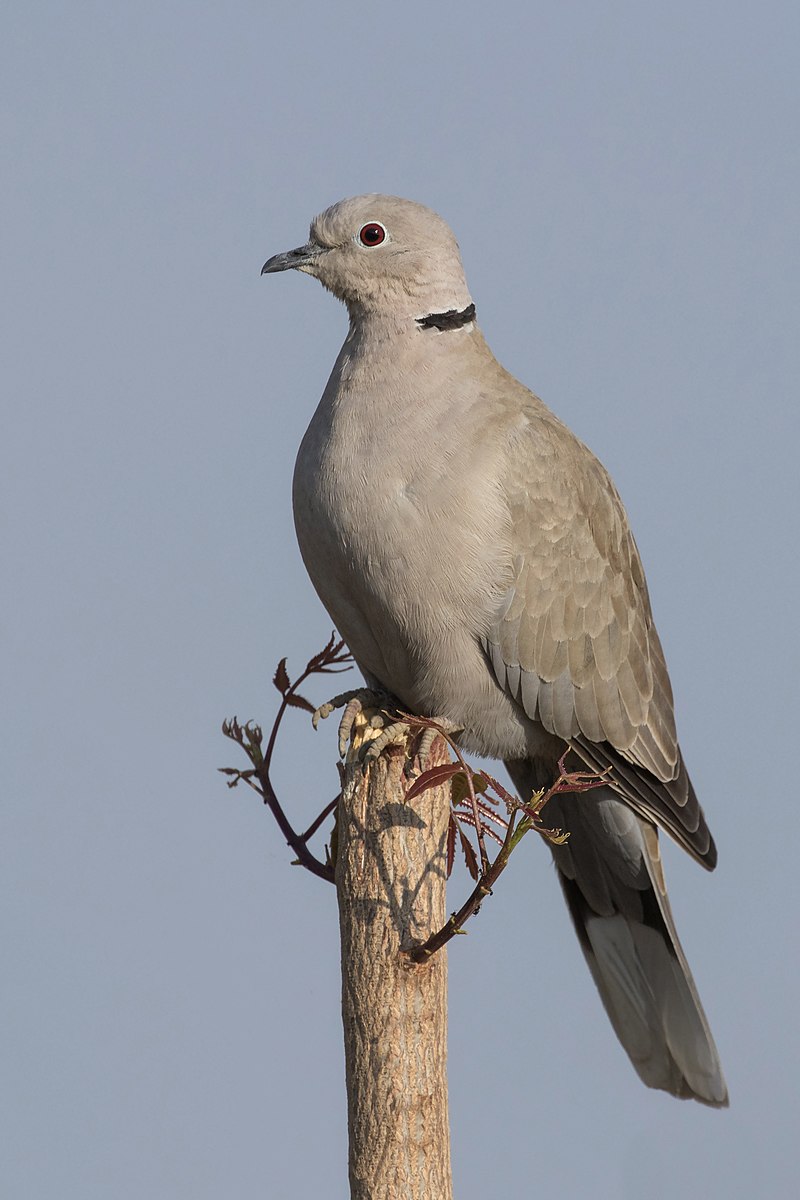
The Eurasian collared dove is a species of bird native to Europe and Asia, with its range expanding through introduction in Japan, North America, and islands in the Caribbean.
It has become so widespread that it is listed as Least Concern on the IUCN Red List. The scientific name for this bird was proposed by Hungarian naturalist Imre Frivaldsz – Columba decaocto.
This beautiful creature typically measures between 33-37 cm from tip to tail feathers, displaying an overall greyish brown plumage; they also have a distinctive black half collar around their neck, which gives them their common name.
These birds are mainly found inhabiting open woodlands or agricultural lands near human settlements where there’s plenty of food available, such as grain fields or gardens where fruits can be eaten off trees.
With a vast global population trend increasing steadily yearly, these birds greatly add to many backyards worldwide.
Scientific classification:
| Kingdom | Animalia |
| Phylum | Chordata |
| Class | Aves |
| Order | Columbiformes |
| Family | Columbidae |
| Genus | Streptopelia |
| Species | S. decaocto |
14. Eurasian Penduline Tit
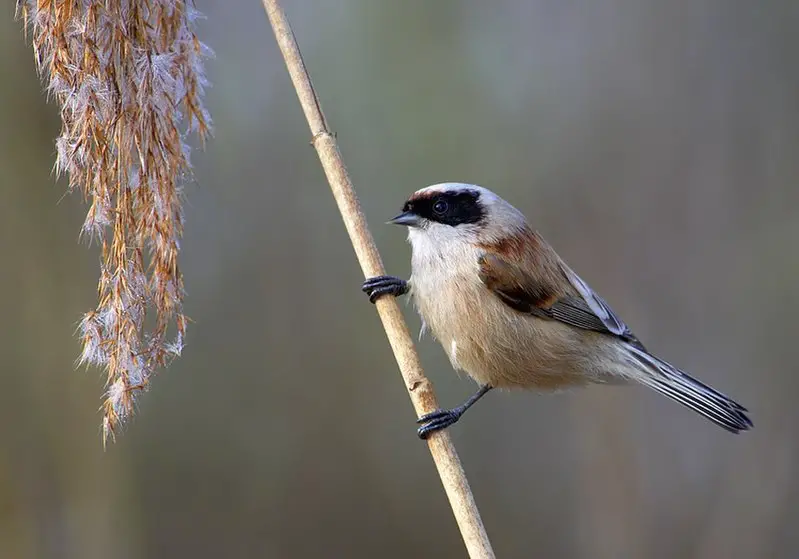
The Eurasian penduline tit is a passerine bird of the genus Remiz which can be found widely across the western Palearctic.
It migrates to more northern parts in summer while staying resident in its southern range during winter months.
This species experienced an expansion of its breeding grounds throughout Western Europe between the 1980s and 1990s, thus increasing its population significantly.
The Penduline Tit has various striking features, like bright yellow underparts with black streaks on the sides.
Greyish-brown upper part with a white underside and pale eye line along head sides and distinctive tail nest made from fibres and mosses hanging from trees or shrubs like a pendulum, hence their name ‘Penduline’.
These birds feed mainly on insects but also eat some seeds, especially sunflower seeds, making them popular garden visitors for many people.
Scientific classification:
| Kingdom | Animalia |
| Phylum | Chordata |
| Class | Aves |
| Order | Passeriformes |
| Family | Remizidae |
| Genus | Remiz |
| Species | R. pendulinus |
15. Common Wood Pigeon
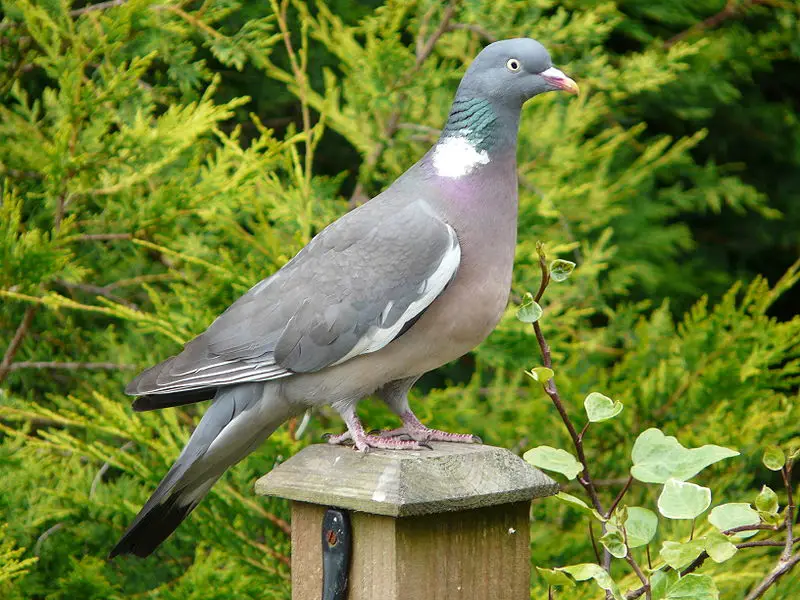
The Common Wood Pigeon is a large bird of the dove and pigeon family, native to the western Palearctic. It has grey plumage with white patches on its wings and neck.
Its head often appears darker than its body due to iridescence in some parts of its feathers. The male woodpigeons have pinkish breasts, while females are more brownish-grey coloured.
These birds feed mainly on seeds, fruits, flowers and leaves but will also eat insects when available.
They breed during springtime, producing 1-2 clutches per breeding season with two eggs each time, which hatch after about 18 days of incubation by both parents taking turns for duty.
They make their nests from twigs collected from nearby trees or places and usually raise only one brood at a time, making them an important part of nature’s balance as they help keep insect populations under control through their diet choices.
Scientific classification:
| Kingdom | Animalia |
| Phylum | Chordata |
| Class | Aves |
| Order | Columbiformes |
| Family | Columbidae |
| Genus | Columba |
| Species | C. palumbus |
16. Skuas
Skuas are a group of predatory seabirds with seven species belonging to the genus Stercorarius.
They are also known as “Jaegers” in North America, and their name originates from the Faroese word for Great Skua – skúgvur.
These birds typically inhabit coastal areas or open oceans where they feed on fish, krill and other marine creatures.
Skuas can be distinguished by their pointed wings, which help them fly long distances while hunting food.
Their distinctive colouration varies depending on age and habitat but generally includes greyish brown upperparts and white underparts with black streaks along its belly area.
The overall size ranges from 24-40 cm, making this one of the larger seabird species.
Scientific classification:
| Kingdom | Animalia |
| Phylum | Chordata |
| Class | Aves |
| Order | Charadriiformes |
| Suborder | Lari |
| Family | Stercorariidae Gray, 1871 |
| Genus | Stercorarius Brisson, 1760 |
17. Dalmatian Pelican
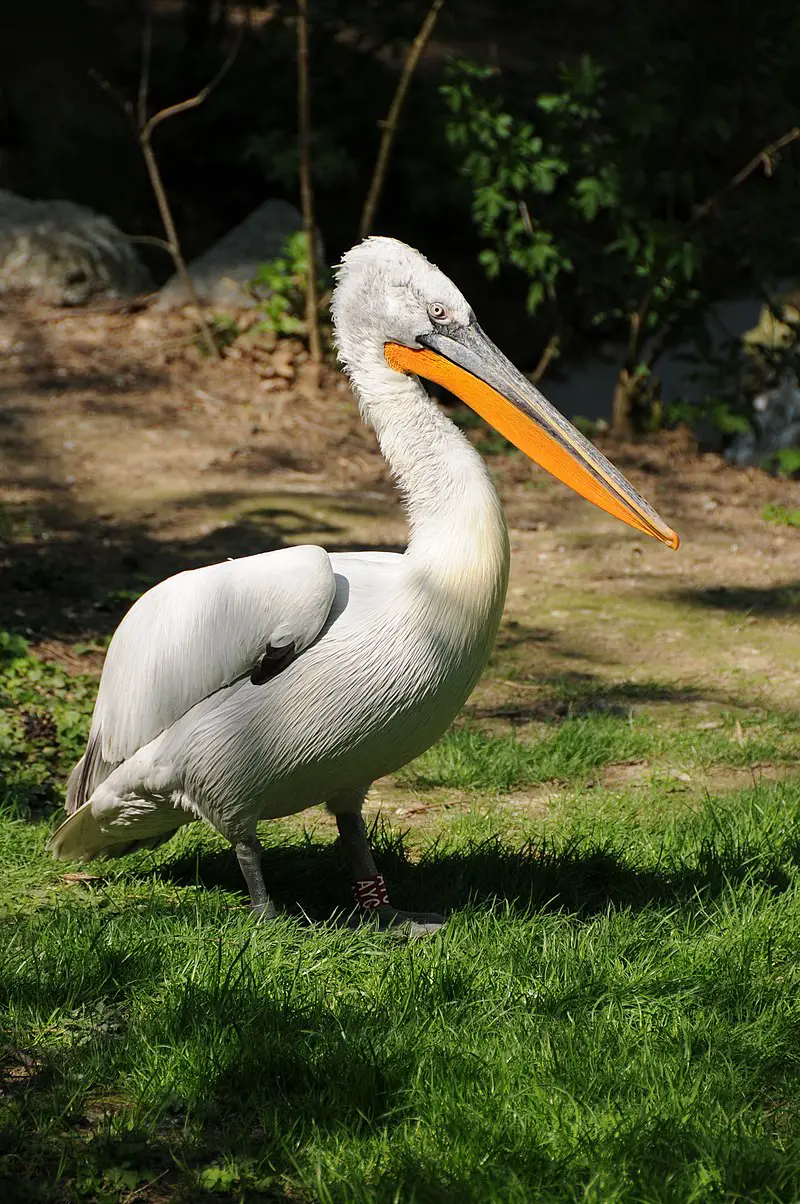
The Dalmatian pelican is an impressive bird, the largest of its family and one of the largest freshwater birds in the world.
Its wingspan rivals even those of albatrosses, and it flies gracefully with other members in synchrony.
It has a wide range across Central Eurasia, stretching from the Mediterranean to India and Southeast Asia and parts of Russia.
This large species has white feathers that are generally lightly tinged with grey or yellow around their head; they have long beaks that can reach up to 40cm long.
Their unique physical characteristics make them stand out among other waterbirds – so if you ever get lucky enough to spot one while exploring nature, take some time to appreciate this majestic creature.
Scientific classification:
| Kingdom | Animalia |
| Phylum | Chordata |
| Class | Aves |
| Order | Pelecaniformes |
| Family | Pelecanidae |
| Genus | Pelecanus |
| Species | P. crispus |
Also Featured In: Most Common Romanian Birds, Birds Found in Hungary
18. Cormorants
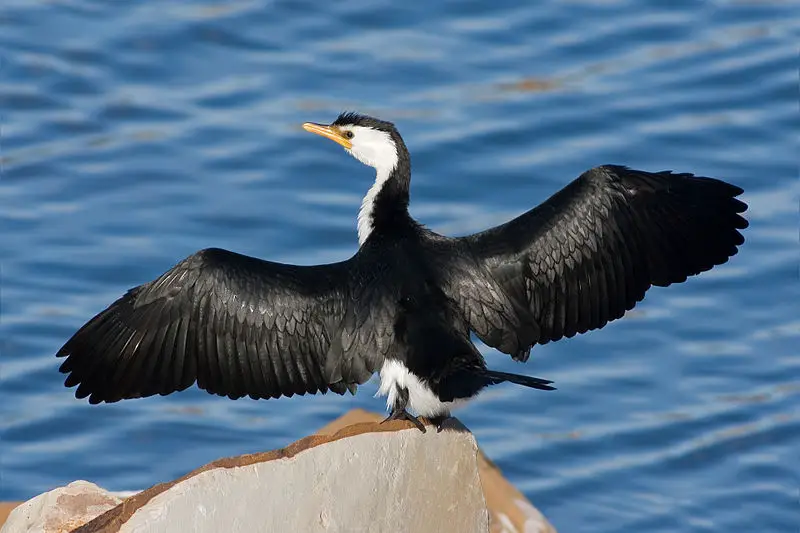
Cormorants are a family of aquatic birds found around the world. They include 40 species, such as great cormorants and common shags.
In Britain, these two species are the most commonly seen in their natural habitats.
Cormorants have long necks and webbed feet and can be identified by their glossy black feathers, which they use to help them easily swim through water as they hunt for food like fish or crustaceans.
They have an impressive wingspan, often reaching up to five feet across when fully extended.
Despite being strong swimmers, these birds also enjoy spending time perched on rocks near rivers or shorelines, where they will preen themselves in order to keep clean and dry during cooler weather conditions.
Scientific classification:
| Kingdom | Animalia |
| Phylum | Chordata |
| Class | Aves |
| Order | Suliformes |
| Family | Phalacrocoracidae Reichenbach, 1850 |
19. Northern Storm Petrels
Northern storm petrels are one of the smallest seabirds, inhabiting oceans worldwide.
They can hover over water and pick planktonic crustaceans and small fish from the surface.
Northern storm petrels belong to the genus Hydrobates in the family Hydrobatidae, part of the Procellariiformes order.
This species was once lumped with austral storm petrel, but recent studies show that they weren’t closely related, leading to them being split into two distinct species.
These birds can be identified by their dark grey upperparts, wings, and white underparts when seen from afar while feeding on the ocean’s surface.
Scientific classification:
| Kingdom | Animalia |
| Phylum | Chordata |
| Class | Aves |
| Order | Procellariiformes |
| Family | Hydrobatidae Mathews, 1912 |
| Genus | Hydrobates F. Boie, 1822 |
20. Pelicans

Pelicans are a family of birds within the Pelicans order, with two genera: Eopelecanus (extinct) and Pelecanus (still existing). They have existed since the late Eocene period — over 40 million years ago.
Pelicans are large waterbirds that can be found in both temperate and tropical regions all over the world.
Their most distinctive feature is their enormous pouched bills; they use these to scoop up fish from rivers or lakes as part of their diet.
These majestic creatures come in various colours, including white, grey, black and brown. When flying in formation, they look like an arrow pointing towards its destination.
Pelicans usually live near bodies of water but may also migrate long distances when food resources become scarce during winter months.
Scientific classification:
| Kingdom | Animalia |
| Phylum | Chordata |
| Class | Aves |
| Order | Pelecaniformes |
| Family | Pelecanidae Rafinesque, 1815 |
Also Featured In: Common Uzbekistan Birds, Common Denmark Birds
21. Sandgrouse
Sandgrouse are birds of the order Pterocliformes, found mainly in Africa and Asia. Sixteen species belong to two genera – Syrrhaptes from central Asia and Pterocles from Africa and other Asian countries.
They inhabit treeless areas such as deserts, steppes, scrublands, or savannas and tend to be ground-dwelling birds that feed on seeds.
Sandgrouse have adapted special features for survival in their harsh environment.
They possess well-developed feet with four toes used for walking over hot sand while keeping their body temperature cool at all times by regulating heat loss through their legs.
Their feathers also act like a sponge, helping them absorb water before flying long distances back home, where they then expel it using specialized glandular secretions located near the wings so that chicks can drink directly from an adult’s breast plumage.
Scientific classification:
| Kingdom | Animalia |
| Phylum | Chordata |
| Class | Aves |
| Clade | Columbimorphae |
| Order | Pterocliformes Huxley, 1868 |
| Family | Pteroclidae Bonaparte, 1831 |
22. Larks
Larks are small passerine birds that belong to the Alaudidae family. These birds have a cosmopolitan distribution and can be found in many different habitats, including dry regions.
The largest number of lark species is located in Africa, while only one species (horned lark) inhabits North America, and another one (Horsfield’s bush lark) lives in Australia.
These beautiful creatures usually appear during dawn or dusk as they sing melodious songs high up in the sky.
Larks possess impressive flying skills, making them capable of reaching heights far above most other bird species.
Despite this skill, they prefer living close to the ground, where there are plenty of seeds and insects for them to feed on.
Scientific classification:
| Kingdom | Animalia |
| Phylum | Chordata |
| Class | Aves |
| Order | Passeriformes |
| Superfamily | Sylvioidea |
| Family | Alaudidae Vigors, 1825 |
23. Thrush
Thrushes are small to medium-sized birds belonging to the Turdidae family and found all over the world. They live on or near the ground and feed on insects, other invertebrates and fruit.
Their feathers range from greyish browns to deep blues in colour, with spotted wings that help them blend into their natural habitats such as forests, woodlands and shrubs.
Thrushes sing distinctive songs during spring mating season; many species also perform complex flight displays for courtship rituals.
These birds may be solitary creatures but can often be seen foraging together in groups or pairs when searching for food sources like worms, snails or berries.
A healthy thrush population indicates a balanced environment since they require clean water sources and plenty of vegetation cover – making them important indicators of ecosystem health worldwide.
Scientific classification:
| Kingdom | Animalia |
| Phylum | Chordata |
| Class | Aves |
| Order | Passeriformes |
| Suborder | Passeri |
| Family | Turdidae Rafinesque, 1815 |
24. Bustard
Bustards are large, terrestrial birds that inhabit dry grassland areas and the steppes of the Old World. They are 40-150 cm long and belong to the family Otididae.
Bustards have an omnivorous diet consisting of leaves, buds, seeds, and fruit, as well as small vertebrates and invertebrates.
These birds usually live a solitary life but can be seen gathering around water sources or food during certain times of the year, such as mating season.
Due to their large size, they are vulnerable to predation by foxes or other animals, so they always remain alert.
When in open spaces, rely on camouflage for protection against predators when out in tall vegetation coverings.
Scientific classification:
| Kingdom | Animalia |
| Phylum | Chordata |
| Class | Aves |
| Clade | Otidimorphae |
| Order | Otidiformes Wagler, 1830 |
| Family | Otididae Rafinesque, 1815 |
25. Threskiornithidae
Threskiornithidae is a family of large wading birds which includes 36 species. These birds are traditionally divided into two subfamilies – the ibises and the spoonbills.
However, recent genetic analysis has shown that spoonbills actually belong to the Old World ibis group, while New World ibises form an early offshoot from this lineage.
Threskiornithidse members have long curved beaks with serrated edges for catching fish in shallow water, mudflats, and other aquatic invertebrates like crustaceans and molluscs.
They also feed on plant matter, such as grains and seeds found close to wetlands areas where they live.
This diverse diet makes them important scavengers in their ecosystems, helping maintain healthy native wildlife populations by controlling insect numbers and dispersing energy-rich seeds throughout wetland habitats.
Scientific classification:
| Kingdom | Animalia |
| Phylum | Chordata |
| Class | Aves |
| Order | Pelecaniformes |
| Suborder | Ardei |
| Family | Threskiornithidae Richmond, 1917 |
26. Phasianidae
The Phasianidae family of birds is one that contains many popular gamebirds, with a total of 185 species divided across 54 genera.
These heavy ground-living birds include pheasants, partridges, junglefowl, chickens, and turkeys, among others like Old World quail and peafowl.
This large family was formerly split into two subfamilies known as the Phasianinae and Perdicinae, but this classification has since been changed to reflect more current scientific findings on them.
All these different types of birds have certain things in common, such as their strong legs for scratching through leaves or soil looking for food items, including insects, seeds, and other vegetation, which makes up most of their diet.
They also all tend to be quite colourful in order to attract mates during the breeding season, when males will often display vibrant feathers or do dances around females in an attempt at courtship ritual displays.
The majority are monogamous creatures, too, although some may form short-term pair bonds before going off alone again once mating has taken place – either way.
Adults tend to give very little parental care after eggs have hatched, so chicks need to fend for themselves immediately.
Scientific classification:
| Kingdom | Animalia |
| Phylum | Chordata |
| Class | Aves |
| Order | Galliformes |
| Superfamily | Phasianoidea |
| Family | Phasianidae Horsfield, 1821 |
27. Procellariidae
Procellariidae is a diverse family of seabirds belonging to the bird order Procellariiformes.
These birds are called tubenoses and include fulmarine petrels, gadfly petrels, diving petrels, prions, and shearwaters.
They range in size from the small storm petrel, which measures around 18cm long, to the giant albatross, which can reach up to 3 meters long.
Depending on the species, they are generally found near oceans or coasts where they feed on fish, squid, and other marine life.
Many procellariids will also nest inland during the breeding season before returning back to sea for most of their lives.
Their wings have specially adapted feathers that give them incredible gliding abilities, allowing them to literally fly with minimal effort over vast distances across oceanic regions.
Scientific classification:
| Kingdom | Animalia |
| Phylum | Chordata |
| Class | Aves |
| Order | Procellariiformes |
| Family | Procellariidae Leach, 1820 |
28. Falcons And Caracaras
Falcons and caracaras are birds of prey that belong to the family Falconidae. They have impressive sharp talons, hooked beaks and keen eyesight, making them excellent hunters.
Falcons can reach speeds up to 200 mph when diving for their prey, while caracaras use a combination of running and flying to hunt small mammals such as rabbits or rats.
Both falcons and caracaras live in various areas worldwide, including grasslands, deserts, forests, wetlands, or even urban areas where they nest on cliffs or tall buildings.
The diet mainly consists of insects and includes larger animals like reptiles or other birds, which they catch by surprise with fast dives out of the sky.
Scientific classification:
| Kingdom | Animalia |
| Phylum | Chordata |
| Class | Aves |
| Order | Falconiformes |
| Family | Falconidae Leach, 1820 |
29. Psittaculidae
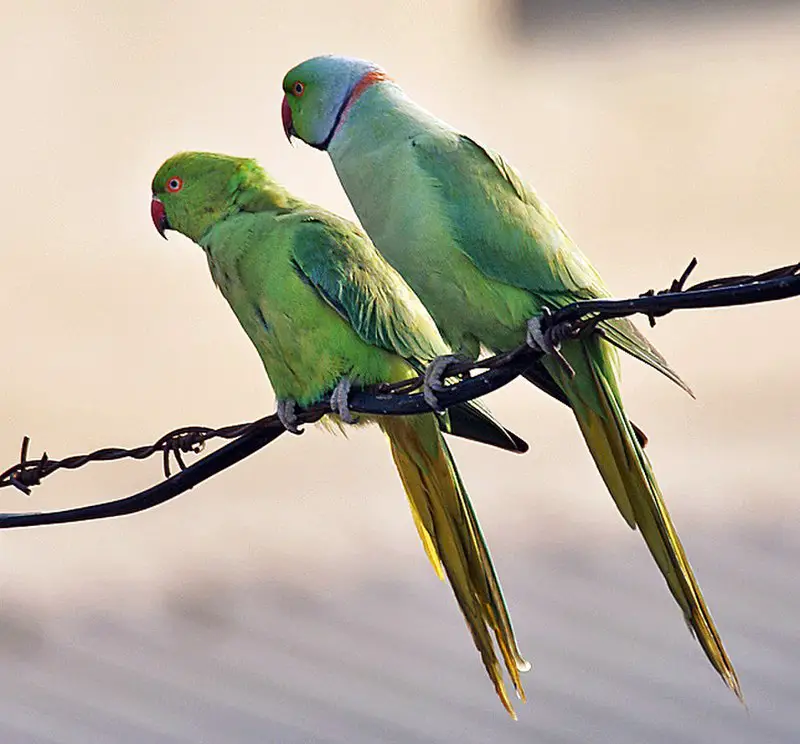
Psittaculidae is a family of Old World parrots that consists of five subfamilies. It includes 192 species divided into 53 genera and has been accepted by the Clements Checklist of Birds and the IOC World Bird List.
These birds are known for their bright colours, strong beaks and powerful vocalisations. They can also mimic human sounds, including words when taught properly with patience and consistency.
They live in warm climate regions such as Africa, Asia Pacific Islands, Australia, and Oceania, where they enjoy abundant and plentiful food sources like fruits, nuts, and seeds.
Psittaculids are typically found living in groups or pairs instead of alone because they enjoy socialising with others from within their own kind.
Scientific classification:
| Kingdom | Animalia |
| Phylum | Chordata |
| Class | Aves |
| Order | Psittaciformes |
| Superfamily | Psittacoidea |
| Family | Psittaculidae Vigors, 1825 |
30. European Bee-Eater
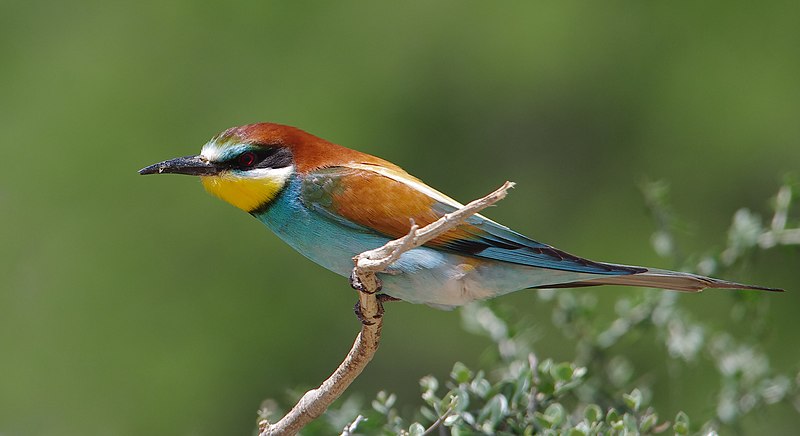
The European Bee-Eater is a stunningly beautiful bird boasting an array of bright colours. Its head and neck are light blue with greenish ear coverts, and its back is chestnut brown.
The wings have yellow primaries bordered in black, while the rest of the feathers contain hues of pink, russet orange, greyish-blue and olive green.
This species can be found breeding throughout Southern Europe to Central Asia as well as Northern Africa to South Africa, where it likes to inhabit open country near rivers or streams with bare banks for nesting purposes.
It migrates during winter months down into tropical areas within both Africa and India but will occasionally overshoot northwards, which may result in rare sightings elsewhere on occasion too.
Scientific classification:
| Kingdom | Animalia |
| Phylum | Chordata |
| Class | Aves |
| Order | Coraciiformes |
| Family | Meropidae |
| Genus | Merops |
| Species | M. apiaster |
31. Western Rock Nuthatch
The Western Rock Nuthatch is a small passerine bird that can be found in parts of Europe and the Middle East. It has an olive-grey back, blackish wings, white underparts with a grey breast band, and a yellow vent area.
Its legs are grey, and its bill is short and broad. This species prefers rocky habitats such as mountainside cliffs or crags used for nesting sites; building cup-shaped nests using mud mixed with grasses or feathers.
They mainly eat insects but consume seeds during winter when food is scarce.
The western rock nuthatch remains largely resident apart from some post-breeding dispersal, making it relatively easy to spot year-round if you know what you’re looking for.
Scientific classification:
| Kingdom | Animalia |
| Phylum | Chordata |
| Class | Aves |
| Order | Passeriformes |
| Family | Sittidae |
| Genus | Sitta |
| Species | S. neumayer |
Also Featured In: Common Serbian Birds, Bulgarian Birds
32. Eurasian Hoopoe
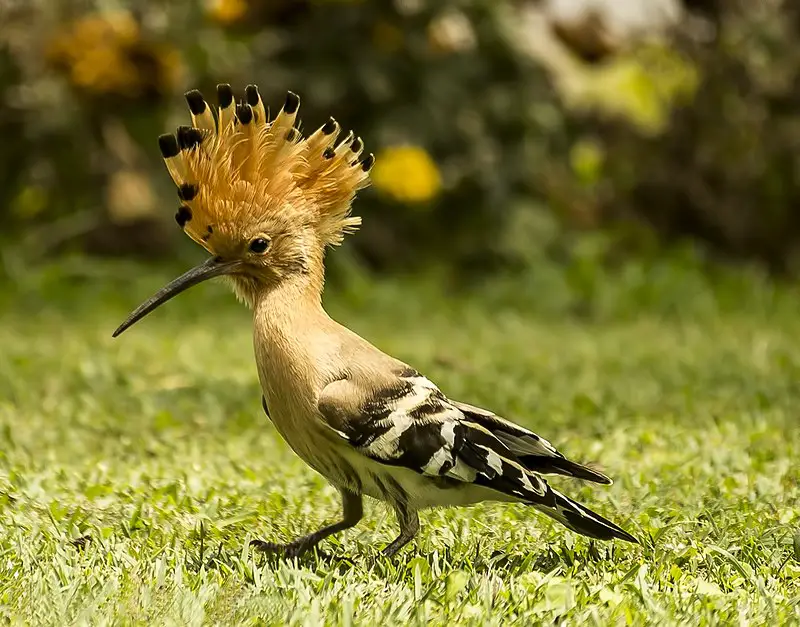
The Eurasian hoopoe is a unique and stunning bird. Its cinnamon-coloured body contrasts sharply with its black-and-white wings, while the tall erectile crest gives it an even more distinctive appearance.
It also has a broad white band and a long, narrow, downcurved beak across its black tail. When you hear this species of bird call, it’s typically “oop-oop-oop”, very soft yet unmistakable in tone.
This beautiful creature can be found throughout Europe, Asia and northern Africa, where they mainly migrate for cooler climates during winter months.
The Eurasian hoopoe is truly one of nature’s most majestic creations – from their vibrant plumage to their mellow calls – making them unforgettable creatures that will never cease to amaze us all.
Scientific classification:
| Kingdom | Animalia |
| Phylum | Chordata |
| Class | Aves |
| Order | Bucerotiformes |
| Family | Upupidae |
| Genus | Upupa |
| Species | U. epops |
33. White-Tailed Eagle
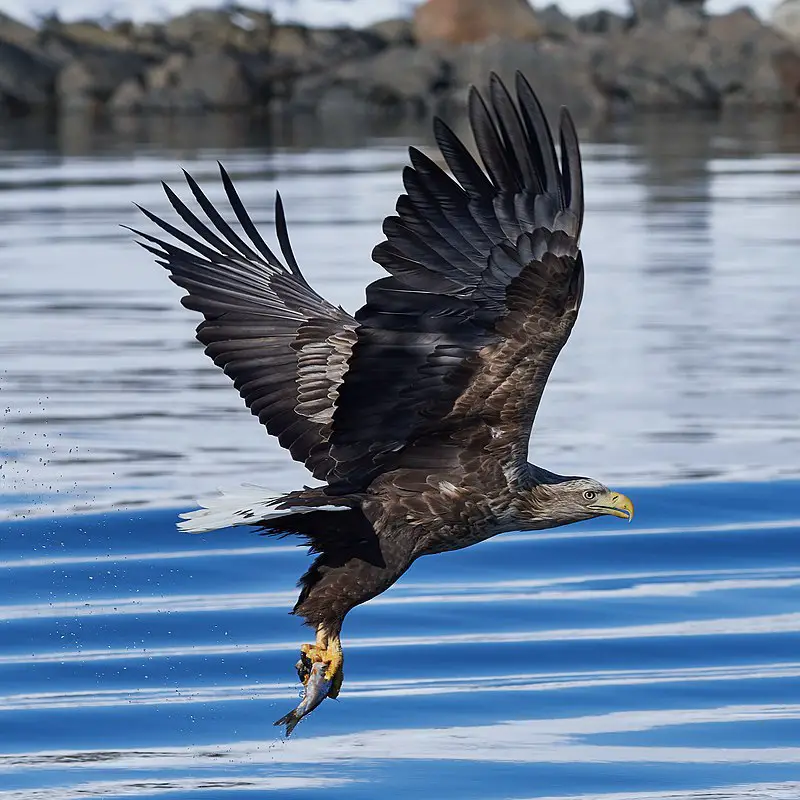
The white-tailed eagle is an impressive species of sea eagle found across temperate Eurasia. This majestic bird belongs to the family Accipitridae, which includes hawks, kites and harriers.
It has a wingspan of up to 2.5 meters and can weigh 4 kilograms or more.
The plumage varies in colour from dark brown above with a paler head and neck while its tail is pure white – hence its name.
They feed mainly on fish but will also take small mammals, birds and carrion when available.
White-tailed eagles are solitary by nature but form pairs during nesting season, typically near bodies of water such as lakes or coasts, where they build large stick nests on trees or cliffsides for their young ones to hatch safely in peace.
Scientific classification:
| Kingdom | Animalia |
| Phylum | Chordata |
| Class | Aves |
| Order | Accipitriformes |
| Family | Accipitridae |
| Genus | Haliaeetus |
| Species | H. albicilla |
34. Cinereous Vulture
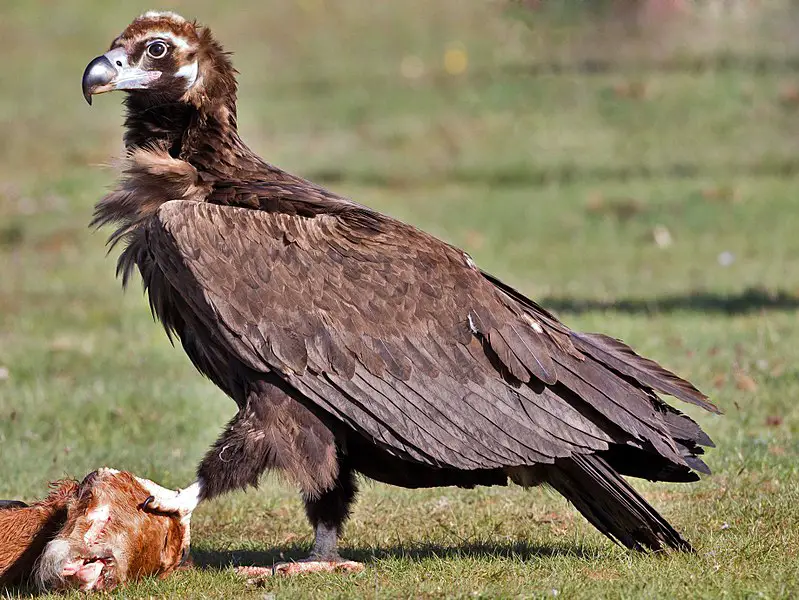
The cinereous vulture, also known as the black vulture, monk vulture and Eurasian black vulture, is a large raptor found in temperate Eurasia. It has an impressive wingspan of 3.1 metres (10 feet) with a body length of 1.2 metres (3 ft 11in).
They are the largest Old World Vultures and can reach weights up to 14 kilograms(31 lbs).
Their diet consists mainly of carrion, but they have been recorded taking live prey such as rodents or hares, allowing them to search for food over wide areas quickly.
These birds usually hunt alone during daylight hours due to their eyesight being well adapted to picking out carcasses from far away distances while soaring high in the sky above open grasslands or wooded hillsides where they breed seasonally between late winter and early autumn, typically laying one egg per pair each year.
Scientific classification:
| Kingdom | Animalia |
| Phylum | Chordata |
| Class | Aves |
| Order | Accipitriformes |
| Family | Accipitridae |
| Genus | Aegypius |
| Species | A. monachus |
35. Purple Heron
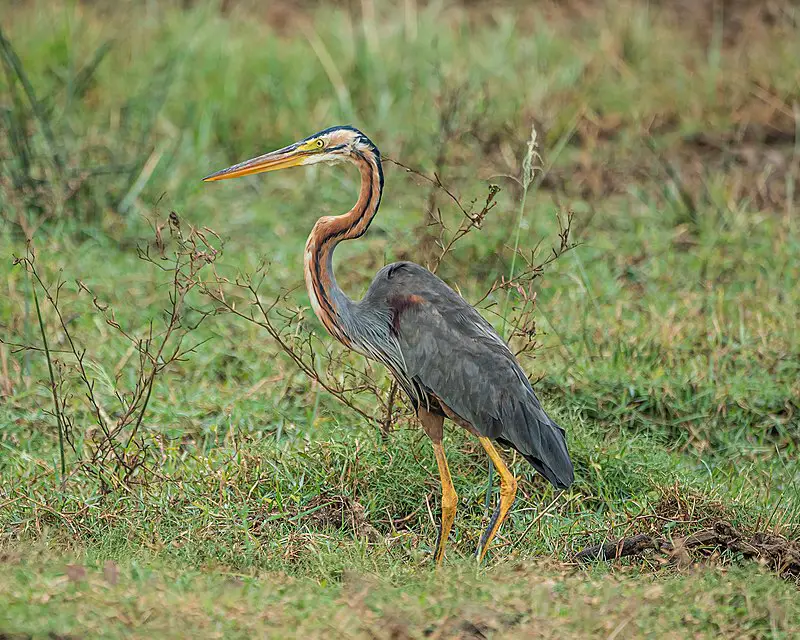
The Purple Heron is a majestic wading bird from the heron family which can be found in Africa, central and southern Europe, and southern and eastern Asia.
It has an impressive wingspan of up to 1.2 meters, and its plumage usually ranges from grey-blue to purple on its back, with brown streaks on its chest.
This species breeds during the summer months before migrating to winter habitats, where they feed mainly on fish or frogs near wetlands or rivers.
The scientific name Ardea purpureus originates from Latin words meaning ‘heron’ and ‘coloured purple’, respectively – referring to this bird’s beautiful colouration.
Scientific classification:
| Kingdom | Animalia |
| Phylum | Chordata |
| Class | Aves |
| Order | Pelecaniformes |
| Family | Ardeidae |
| Genus | Ardea |
| Species | A. purpurea |
Also Featured In: Ukrainian Birds You Should Know, Common Birds in Tuscany
36. Rock Partridge
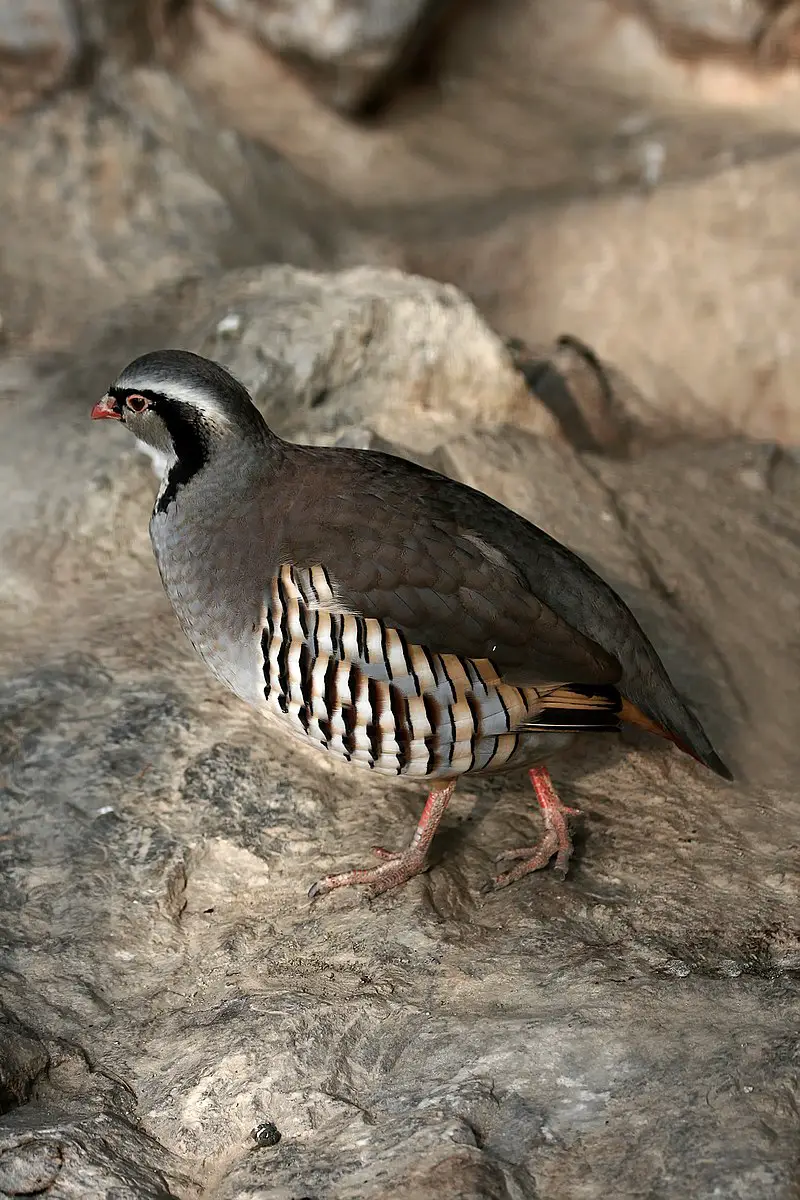
The Rock Partridge is a gamebird in the pheasant family and is native to southern Europe. It closely resembles its eastern counterpart, the Chukar Partridge.
This bird resides in dry and open hillsides, where it builds its nest on a shallow ground scrape that’s only lightly lined with material for insulation.
The rock partridge has long been an important prey species among hunters due to its size and relative ease of finding during hunting expeditions.
Although these birds are not endangered at present, their population numbers have declined significantly over recent years due to poaching and habitat destruction caused by human activities such as farming or urbanization projects.
Conservation efforts must be taken if we want this unique bird species to stay around us for future generations.
Scientific classification:
| Kingdom | Animalia |
| Phylum | Chordata |
| Class | Aves |
| Order | Galliformes |
| Family | Phasianidae |
| Genus | Alectoris |
| Species | A. graeca |
Also Featured In: Birds Commonly Found in Slovenia, Birds that Live in Montenegro
37. Black-Headed Bunting
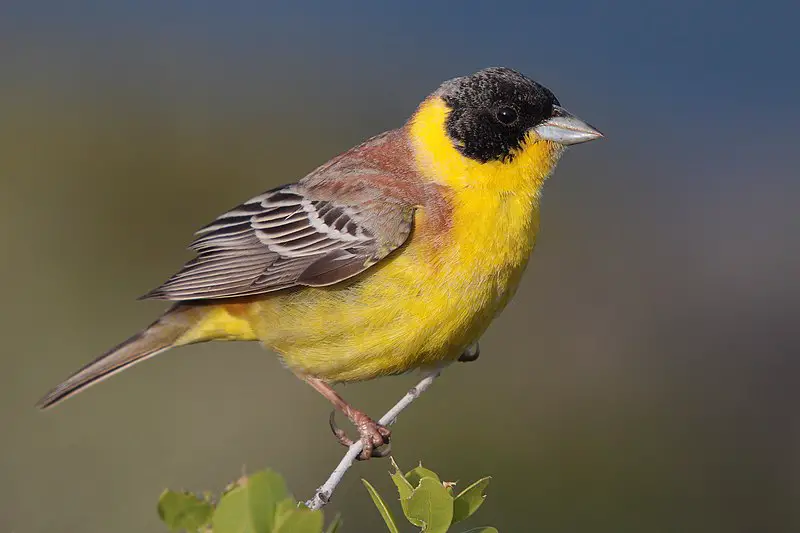
The Black-headed Bunting is a passerine bird found in the Emberizidae family. It breeds mainly in south-east Europe and east to Iran, with some migrating further into India and south-east Asia during winter.
Being an open grassland species, it usually travels in flocks looking for grain and seed to eat.
Adult males have distinctive black heads that contrast against their brown upperparts, yellow underparts and white wing patches, which are readily visible while they’re flying.
Females lack this bright plumage but still show a dark streak across their heads instead.
They make loud calls when gathering together or defending territories from other birds of similar size.
Scientific classification:
| Kingdom | Animalia |
| Phylum | Chordata |
| Class | Aves |
| Order | Passeriformes |
| Family | Emberizidae |
| Genus | Emberiza |
| Species | E. melanocephala |
Also Featured In: Birds You’ll Find in Albania,
38. Red-Backed Shrike
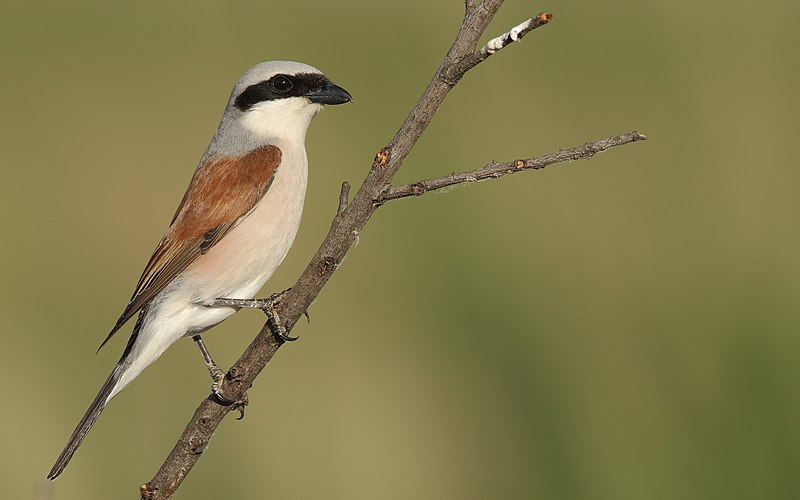
The Red-backed Shrike is a beautiful member of the Shrike family, found in Western Europe and central Russia. It is easily identified by its grey mantle, black wings with white spots and red back.
In summer, they migrate to eastern tropical Africa or southern Africa, where they overwinter.
This bird feeds mainly on insects but also occasionally eats small mammals, reptiles, and other birds and fruit.
They are known for their hunting techniques, which include perching high up in trees and then diving down onto their prey below them before returning to eat it at leisure elsewhere.
The Red-backed Shrike is an impressive sight that lives both in our gardens and far away places.
Scientific classification:
| Kingdom | Animalia |
| Phylum | Chordata |
| Class | Aves |
| Order | Passeriformes |
| Family | Laniidae |
| Genus | Lanius |
| Species | L. collurio |
39. Woodchat Shrike
The Woodchat Shrike is a unique species of bird belonging to the Shrike family. It has an unmistakable red-brown crown and nape, making it easily distinguishable from other birds.
This species mainly feeds on insects but will also take small vertebrates if they are available.
They have adapted well to living in open wooded areas with scattered trees, such as orchards, where there’s plenty of bare ground for them to hunt on.
During the breeding season, the Woodchat Shrikes can be found throughout Southern Europe, the Middle East and Northwest Africa, while during wintertime, these fascinating creatures migrate south towards tropical regions of Africa for warmer weather conditions.
This species makes a fantastic addition to any outdoor environment, so why not give them some extra attention next time you spot one?
Scientific classification:
| Kingdom | Animalia |
| Phylum | Chordata |
| Class | Aves |
| Order | Passeriformes |
| Family | Laniidae |
| Genus | Lanius |
| Species | L. senator |
Also Featured In: Italian Birds You Should Know, Common Slovakian Birds
40. European Roller

The European roller is a beautiful bird belonging to the Coracias family, and it’s the only one of its kind found in Europe.
It inhabits habitats such as dry wooded savanna, bushy plains, and other areas except treeless ones.
During wintertime, they usually nest in tree holes, while their range extends into the Middle East, Central Asia and the Maghreb regions.
They have vibrant blue feathers with black stripes along the neck area, making them stand out from other birds easily.
Its diet consists mainly of insects like grasshoppers or beetles that are hunted by catching them mid-air during flight; this feature adds an extra charm to these magnificent creatures.
Scientific classification:
| Kingdom | Animalia |
| Phylum | Chordata |
| Class | Aves |
| Order | Coraciiformes |
| Family | Coraciidae |
| Genus | Coracias |
| Species | C. garrulus |
41. Shorebirds
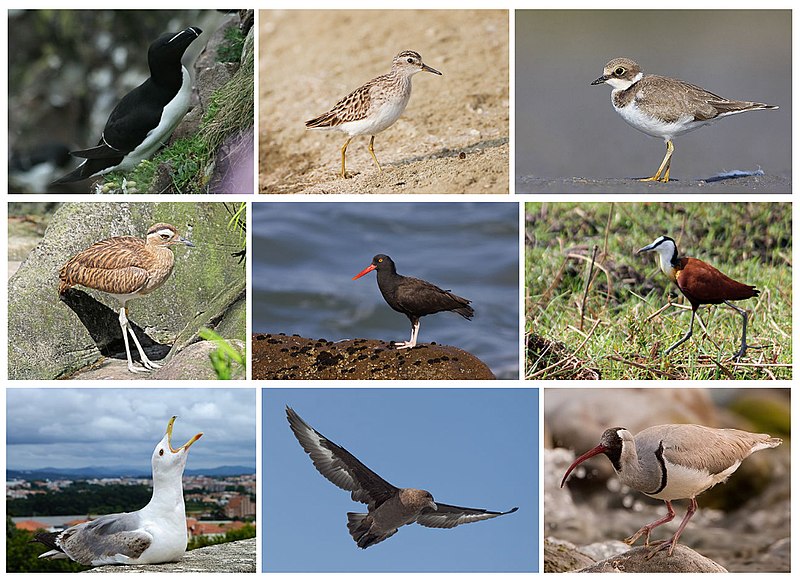
Shorebirds, a diverse group of birds in the Charadriiformes order, are found near water on every continent except Antarctica.
These small to medium-sized birds feed mainly on invertebrates and other small animals but can also be pelagic seabirds or inhabit deserts.
Shorebirds use their long bills to probe mudflats for food like worms and molluscs, while some species plunge into the ocean’s depths in search of crustaceans such as crabs and shrimp.
They have strong legs equipped with webbed feet, allowing them to move quickly when searching for prey across wetlands, sandbars, beaches and swamps.
Their feathers make them well adapted to life by land or sea due to their hydrophobic nature, which helps reduce drag during swimming or flying through windy conditions, making it easier for shorebirds to survive tough environments worldwide.
Scientific classification:
| Kingdom | Animalia |
| Phylum | Chordata |
| Class | Aves |
| Infraclass | Neognathae |
| Clade | Neoaves |
| Clade | Gruimorphae |
| Order | Charadriiformes Huxley, 1867 |
42. Black Tern
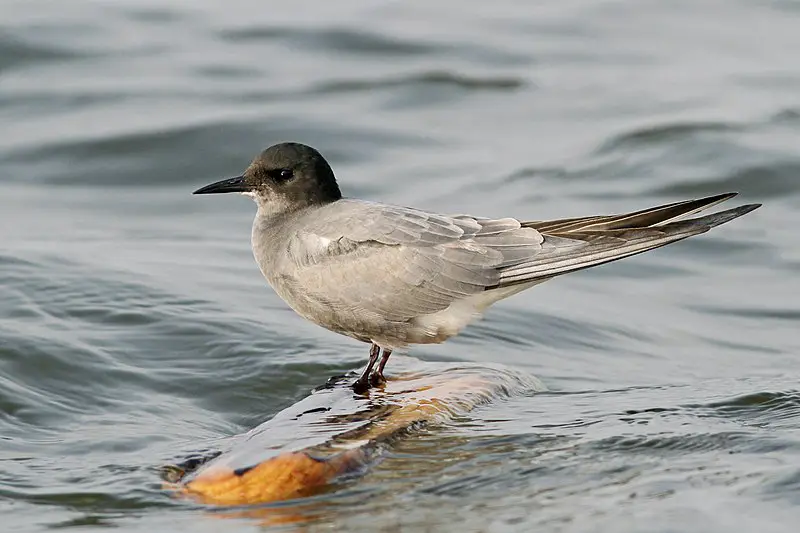
The black tern is a small yet distinctive bird found in or near inland water habitats throughout Europe, Western Asia and North America.
Its plumage appears darkly coloured from a distance but can shine with an iridescent blue hue up close when breeding season arrives.
Its name is believed to come from the Old English word ‘blue darr’, which references the colour of its feathers in certain lights.
The genus Chlidonias derives its name from the Greek meaning ‘swallow-like’ due to its appearance and behaviour, which are similar to those of these birds while they are fishing for food in shallow waters.
An interesting species, it has appeared in artwork dating back centuries and, more recently, inspiring music compositions.
Scientific classification:
| Kingdom | Animalia |
| Phylum | Chordata |
| Class | Aves |
| Order | Charadriiformes |
| Family | Laridae |
| Genus | Chlidonias |
| Species | C. niger |
Also Featured In: Birds You’ll Find in Moldova, Armenian Birds You Should Know
43. Lesser Kestrel
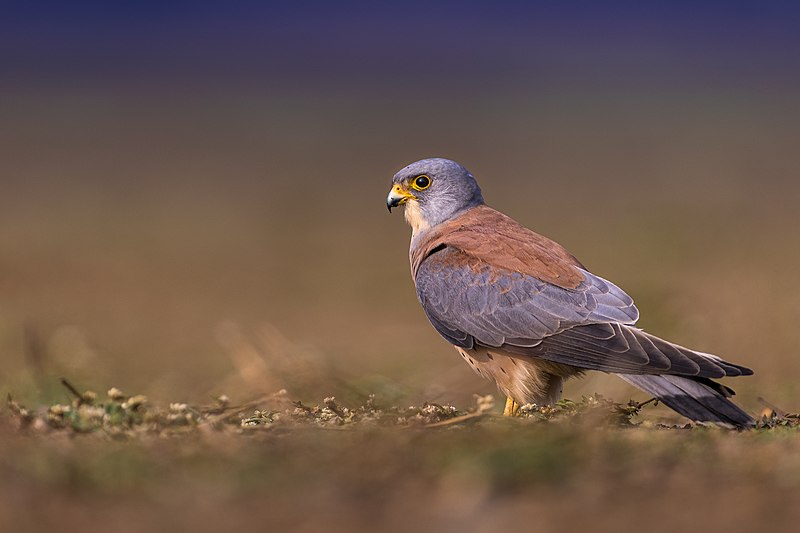
The Lesser Kestrel is a small falcon species that breeds in various regions of the Mediterranean, Afghanistan, Central Asia, China and Mongolia. During summer, they migrate to Africa, Pakistan, India, or Iraq.
The population of this bird has been declining in its European range, but it remains rare north of its breeding locations.
Its genus ” Falco ” derives from Late Latin meaning sickle, which describes their curved beak shape used for hunting prey like insects or lizards.
Their diet also consists mainly on seeds and grains as well as some fruits when available making them versatile hunters able to survive different climates where food may vary seasonally.
Scientific classification:
| Kingdom | Animalia |
| Phylum | Chordata |
| Class | Aves |
| Order | Falconiformes |
| Family | Falconidae |
| Genus | Falco |
| Species | F. naumanni |
Also Featured In: European Birds, Most Common Spain Birds
44. Isabelline Wheatear
The Isabelline Wheatear is a small passerine bird belonging to the Muscicapidae family. It can be found in steppes and open countryside, breeding from southern Russia through Central Asia all the way down to northern Pakistan.
During wintertime, it migrates southwards for warmer climates. Its diet mainly consists of insects, making this species insectivorous.
Its usual hunting ground is on low vegetation or on bare soil, where it searches for food with its agile movements and sharp bill.
The males are distinguished by their grey upper parts, the light underside with buff markings around wings and tail, as well as their white brow stripe that gives them their name: “Isabella”.
Scientific classification:
| Kingdom | Animalia |
| Phylum | Chordata |
| Class | Aves |
| Order | Passeriformes |
| Family | Muscicapidae |
| Genus | Oenanthe |
| Species | O. isabellina |
45. Eurasian Scops Owl
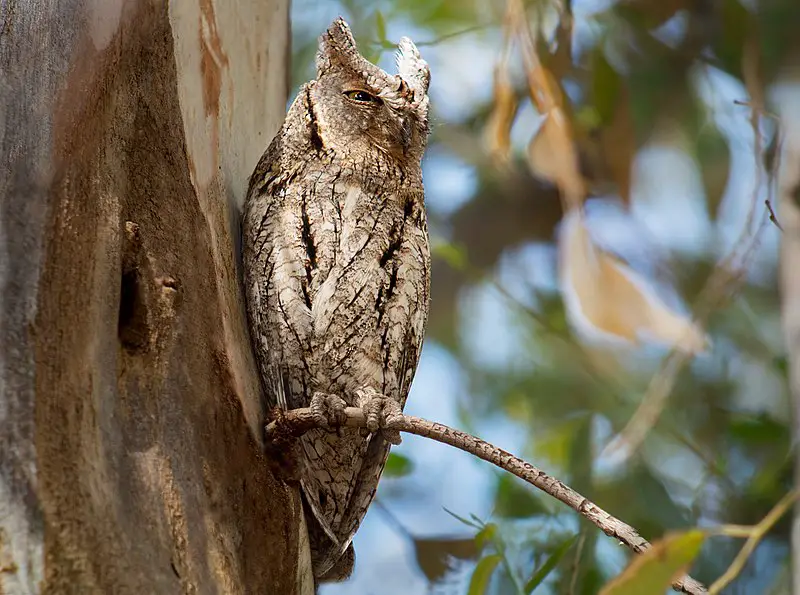
The Eurasian scops owl is a small bird in the Strigidae family. Its breeding range stretches from southern Europe to Southern Siberia and into the western Himalayas.
During winter, it migrates south of the Sahara Desert in Africa. This species was formally described by Swedish naturalist Carl Linnaeus back in 1758.
They have ear tufts on their head, which are actually feathers used for camouflage among tree branches; they also provide visual communication with other owls nearby – an important part of survival.
The Eurasian Scops Owl typically eats insects such as crickets, beetles and moths found around its habitat.
These birds ensure our environment stays balanced with nature by keeping insect populations down.
Scientific classification:
| Kingdom | Animalia |
| Phylum | Chordata |
| Class | Aves |
| Order | Strigiformes |
| Family | Strigidae |
| Genus | Otus |
| Species | O. scops |
46. Krüper’s Nuthatch
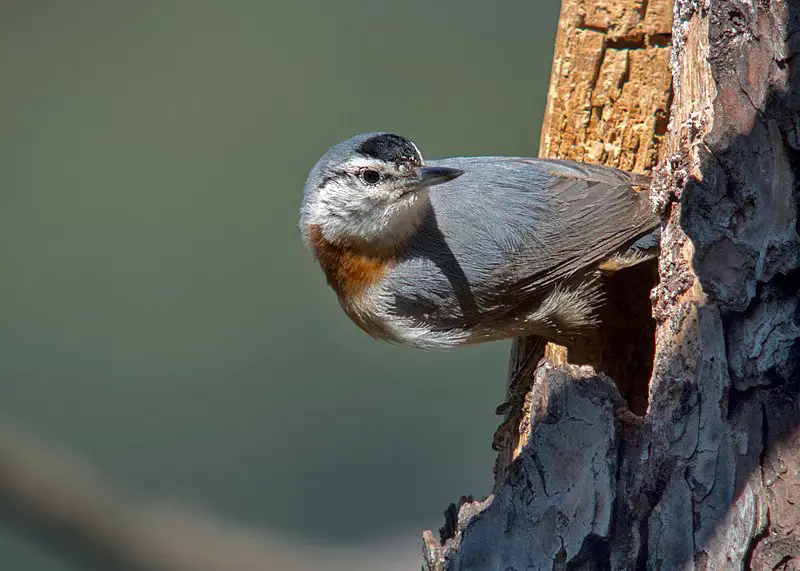
Krüper’s nuthatch is a species of bird in the Sittidae family. It has blue-grey upper parts with black or grey eyestripe and white supercilium, while its underparts are yellowish-white to pale buff. The front half of the crown is black for adult males but less prominent for females.
This small to medium-sized bird measures 12.5 centimetres (4.9 inches) in length and can be found from southeastern Bulgaria through Turkey into northeastern Iraq and Armenia, as well as Iran’s Turkmen Sahra region near Ashgabat city.
They inhabit deciduous forests dominated by oak trees, feeding on tree bark insects while climbing up and down trunks like other nuthatches do.
Scientific classification:
| Kingdom | Animalia |
| Phylum | Chordata |
| Class | Aves |
| Order | Passeriformes |
| Family | Sittidae |
| Genus | Sitta |
| Species | S. krueperi |
Also Featured In: Common Birds of Lesbos Island,
47. Greater Flamingo
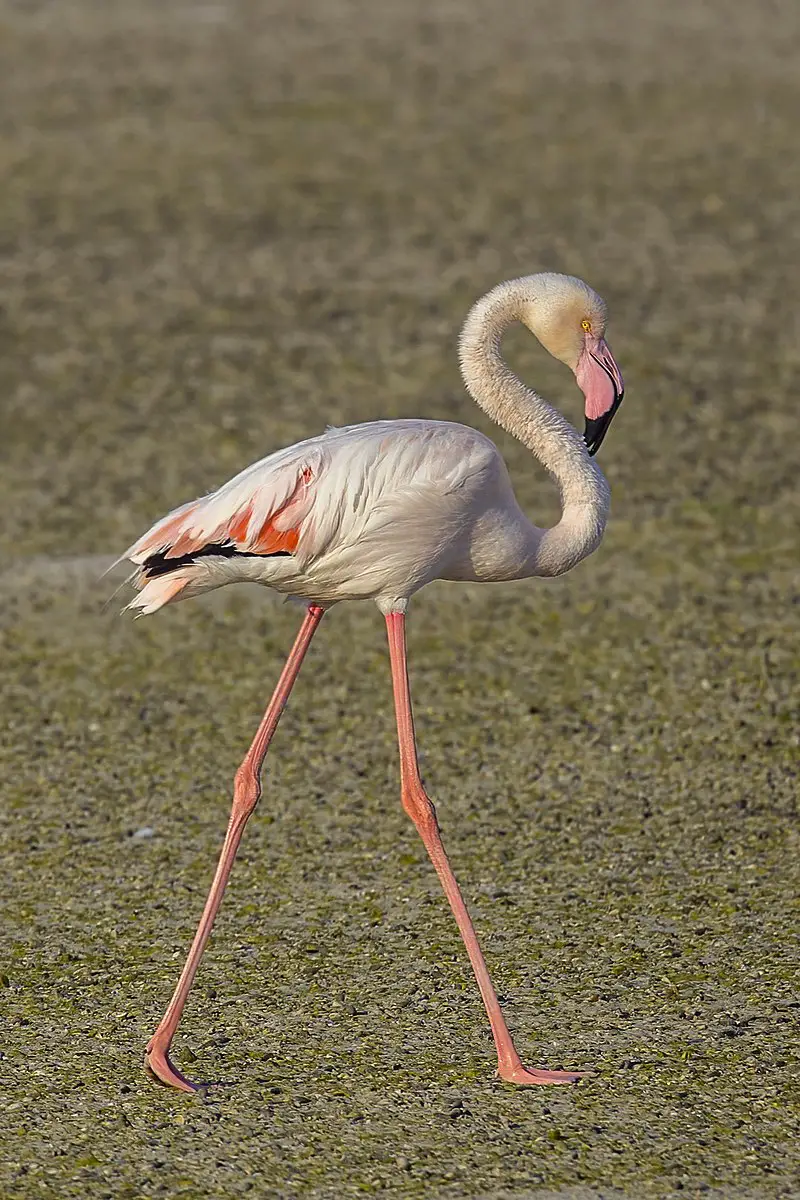
The Greater Flamingo is an impressive bird belonging to the Phoenicopteridae family. It’s one of the most widespread and largest species among flamingos, with a range covering Africa, India, the Middle East and southern parts of Europe.
The bird was described by Peter Simon Pallas in 1811 but it wasn’t until recently that it was distinguished from American Flamingo (Phoenicopterus ruber), due to differences in coloration between them.
This large-bodied wading bird stands tall at 1m on average and has bright pink plumage adorning its long neck and legs, which gives way to black wing tips when flying.
Its diet mainly consists of algae, crustaceans, and small aquatic animals like mollusks found while feeding along shallow lakes or lagoons where they live their social lives surrounded by others just like them.
Scientific classification:
| Kingdom | Animalia |
| Phylum | Chordata |
| Class | Aves |
| Order | Phoenicopteriformes |
| Family | Phoenicopteridae |
| Genus | Phoenicopterus |
| Species | P. roseus |
48. Rook
Rooks are a species of black-feathered birds found in the Palearctic region from Scandinavia to eastern Siberia. They have distinctive white, featherless areas on their faces and nest communally in tall trees.
Rooks are social creatures that often forage together for food, such as insects, earthworms, seeds and small animals like mice or frogs.
They also enjoy bathing regularly in shallow pools of water and dusting themselves off afterwards with dry soil or sand.
In addition to providing protection against parasites when nesting high up in the treetops, rooks will use communal roost sites during winter nights, which can contain thousands of individuals all huddled close together.
Scientific classification:
| Kingdom | Animalia |
| Phylum | Chordata |
| Class | Aves |
| Order | Passeriformes |
| Family | Corvidae |
| Genus | Corvus |
| Species | C. frugilegus |
Also Featured In: Flocks Birds around Us, Most Common Lithuanian Birds
49. Whinchat
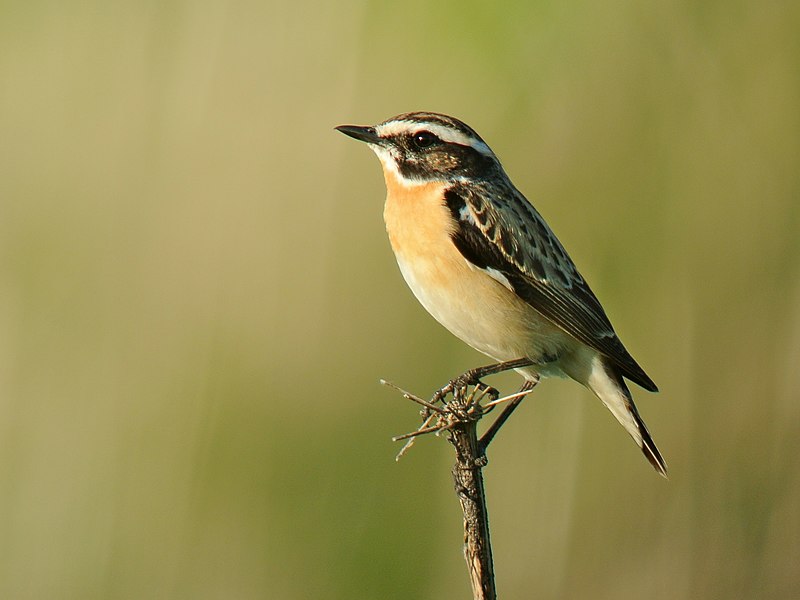
The Whinchat is a small passerine bird found in Europe, western Asia and central Africa. This species was once thought to belong to the thrush family, but now it has been moved into the Old World flycatcher group.
Both males and females have an obvious supercilium (eyebrow) and mottled brownish upper parts that create a distinct pattern of dark markings.
The throat and breast are pale, while its belly ranges from buff-white colouration.
They also feature pointed wings with white wing bars and long legs for ground feeding when needed during migration periods or nesting times.
Usually seen alone, these birds spend time perching on posts or low shrubs before making short flights between habitats in search of food such as insects, spiders and other invertebrates, which they usually catch by hovering briefly over them first before snatching them up.
Scientific classification:
| Kingdom | Animalia |
| Phylum | Chordata |
| Class | Aves |
| Order | Passeriformes |
| Family | Muscicapidae |
| Genus | Saxicola |
| Species | S. rubetra |
Also Featured In: Birds of Latvia, Moorland Birds You Need to Know
50. Western Black-Eared Wheatear
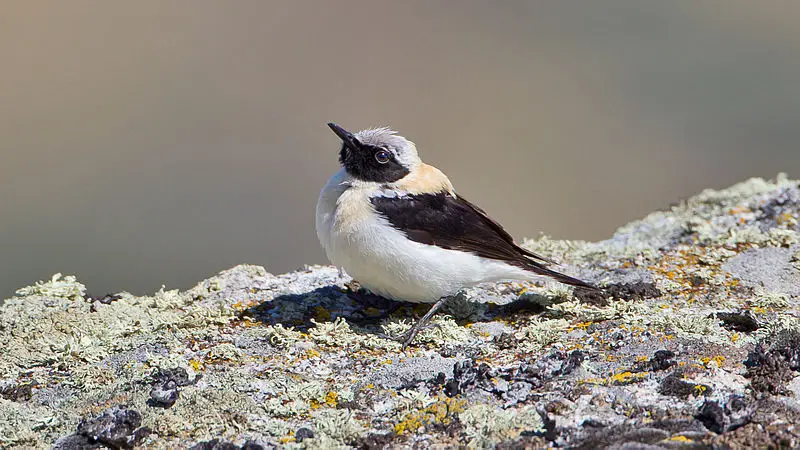
The Western black-eared wheatear is a small migratory passerine bird with an Old World flycatcher family.
The breeding males have a distinctive forehead and crown of white, contrasting sharply against their jet-black facial mask and ear patch.
They also feature greyish brown upperparts, pale underparts, light wings with two bold white bars across them, reddish tail feathers and pink legs.
These birds breed in open habitats like steppes or semi-deserts from Portugal to Central Asia during the summer months before taking off on long-distance migration routes that take them all the way south to Sub-Saharan Africa for wintering grounds.
Their diet mainly consists of insects, which they catch by flying up into the air after perching on low vegetation or rocks near their prey’s location.
Scientific classification:
| Kingdom | Animalia |
| Phylum | Chordata |
| Class | Aves |
| Order | Passeriformes |
| Family | Muscicapidae |
| Genus | Oenanthe |
| Species | O. hispanica |
51. Common House Martin
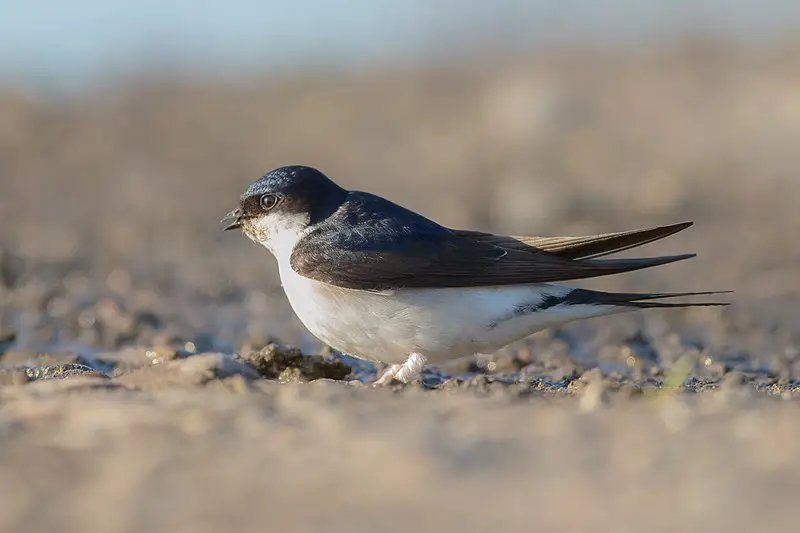
The Common House Martin is a beautiful migratory bird of the swallow family. It breeds in Europe, North Africa, and the Palearctic region, then winters in sub-Saharan Africa and tropical Asia.
This species feeds on insects caught while flying through its habitat.
Its main food source changes depending on where it is located at any given time as it follows warmer climates with more abundance of flies during winter months when migrating southward from its breeding grounds up north.
The house martin has an unmistakable appearance; they have glossy blue upperparts and white underparts that contrast beautifully against their black wingspan, reaching up to 18 cm long.
Scientific classification:
| Kingdom | Animalia |
| Phylum | Chordata |
| Class | Aves |
| Order | Passeriformes |
| Family | Hirundinidae |
| Genus | Delichon |
| Species | D. urbicum |
Also Featured In: Flight Birds You Should Know, Common Birds in the Cities